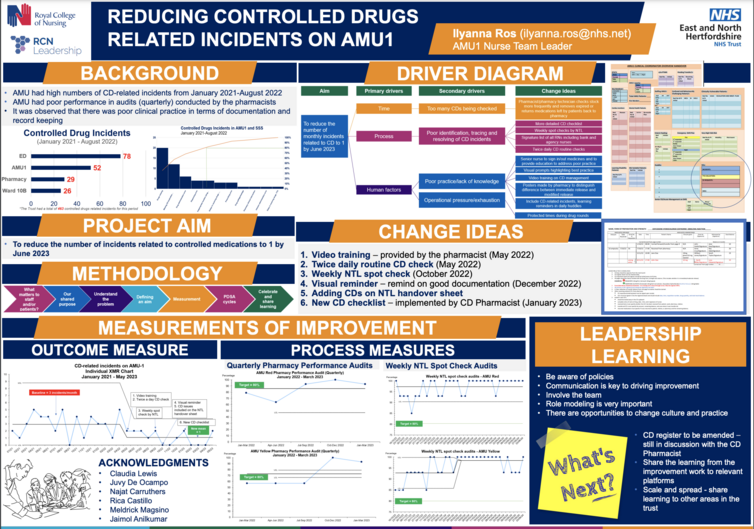Poster uploaded
Setting: Acute Medical Unit 1 (AMU1), Lister Hospital, East and North Hertfordshire NHS Trust
Background: AMU had high numbers of controlled drugs (CD) -related incidents from January 2021 – August 2022. The unit also had quarterly performance audits conducted by the pharmacists. On observation, there was poor practice in terms of documentation and record keeping
What matters to you? Conversations: The project team asked the team: what does good CD management look like, what are the enablers, what are the barriers, and what are change ideas they think would work. These were themed and was included in the project’s driver diagram.
Shared purpose: The project included the project lead (nurse team leader), the ward manager, the nurse educator for the ward, two nurse team leaders, a quality improvement coach, a divisional quality manager and a quality improvement coach.
Understanding the problem: Most CD-related incidents were around improper documentation/missing inputs.
Project aim: To reduce the number of incidents related to controlled medications to from 3 to 1 by June 2023.
Drivers: Time (too many CDs being checked), process (poor identification, tracing and resolving of CD incidents), Human factors (poor practice/lack of knowledge, operational pressure/exhaustion)
Measurement:
Outcome: The monthly CD-related incidents on AMU1
Process: Quarterly Pharmacy Performance Audits, Weekly NTL spot check audits
Change ideas tested: Video training, twice daily routine CD check, visual reminders, weekly nurse team leader (NTL) spot checks, Adding CDs on NTL handover, new CD checklist.
Outcome: Number of monthly incidents decreased from 3 to 1 and improvement sustained, quarterly pharmacy performance audit above target of 80%, nursing team leader weekly spot check audits above target of 80%.

Ilyanna-Ros---Reducing-the-number-of-CD-related-incidents-on-AMU1.pdf
